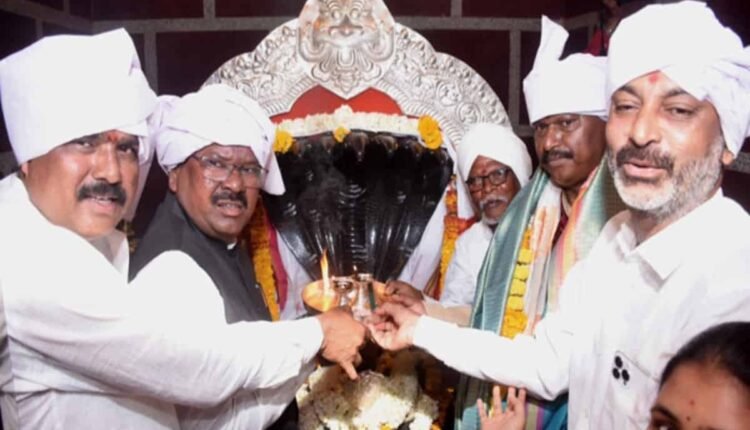Nagoba : A Unique Fair In Worshiping Of Serpent Deity
Nagoba : Jathara, held in Keslapur village near Mutnoor of Indravelli Mandal in Adilabad, is a unique fair that revolves around the worship of the serpent deity Nagoba. It has been designated as a state festival and attracts a large number of people, despite Keslapur being a small village with a population of around 400. The fair takes place over four days, from January 25th to 29th.
The fair begins on the Amavasya day of the Pushya month. The tribal communities believe that worshipping Nagoba brings prosperity to their crops, ensures peace, and helps ward off diseases.
Nagoba History
It Varies according to the beliefs of the Gond tribes. One version narrates that Nagendra appeared in a dream to Rani Nagaimoti of the Mesram family and promised to be born as a serpent in her womb, which later came true. Nagendra, in his serpent form, married Gauri, the daughter of Rani’s younger brother. While traveling in a basket to Godavari, a snake in the form of an Udum (a type of lizard) appeared, and the place was named Udumpur.
At Dharmapuri, while Gauri went to bathe in the Godavari, Nagendra transformed into a human form and was presented with a choice between name, prestige, and tradition. As she did not consider the traditions, he turned back into a snake.
According to legend, Gauri searched for Nagendra from Udumpur to Garimela and eventually merged with Satyavasi Gundam in Godavari, while the bull kept by Nagendra turned into a stone. Nagendra, who later became known as Nagoba, went to the Keslapur hills.
The Nagoba temple was built on the hill where Nagendra went, and it is believed that Nagendra appears every year on the new moon day of the Pushya month. The Mesram clans, who worship Nagoba, perform the pujas at the temple. The Mesram clan consists of 22 tribes and those belonging to the Mesram clan participate in the fair.
During the fair, the Mesram clansmen undertake a journey to fetch water from the Godavari, walking 80 kilometers from Keslapur to Godavari. They bring the water back in new pots and, on the night of Amavasya, perform an anointing ceremony under a sacred Banyan tree at the fairgrounds. The fair involves various tribal rituals and traditions, and it is customary to change the priest every three years.
One notable aspect of the fair is the cooking arrangements. Although thousands of Mesram clansmen attend the fair, they cook on only 22 stoves placed on special shelves called “dugudu.” Other attendees can cook anywhere they wish.
The fair also includes a Durbar, which was initially organized by Professor Hyman Dorf in 1946. The Durbar aims to address the issues faced by the tribal communities living in remote areas. It takes place on the last day of the fair and is attended by tribal elders, leaders, public representatives, and officials.
After the Nagoba pujas, the mound in the Nagoba temple premises is covered with mud, and the idols of the Mesram clans are buried. Sons-in-law of the Mesram clan trample the soil with their feet, making it soft, while daughters use Methi (Aliki) to fulfill their consecration or vows. It is a tradition to give a special Nazarana (offering) to the Alluls for their role in treading the soil. Devotees from Maharashtra, Madhya Pradesh, Odisha, and Chhattisgarh also attend this fair to offer their prayers.
Also Read : Bonalu : Big Celebrations At Jagadamba Temple In Golconda

